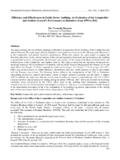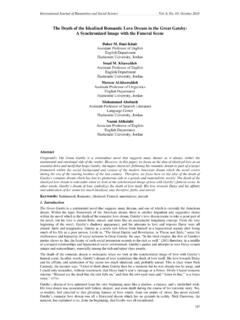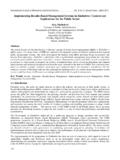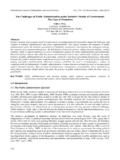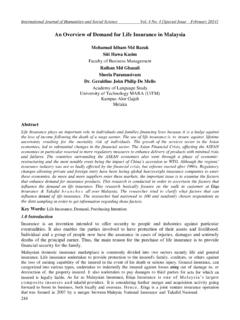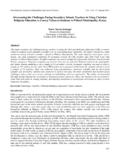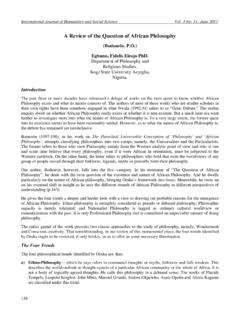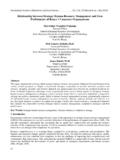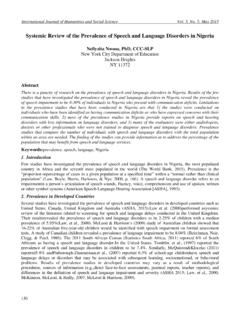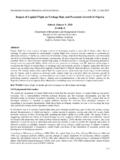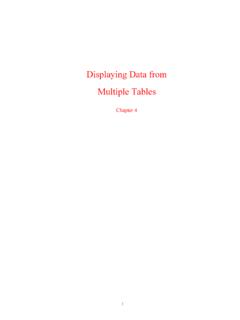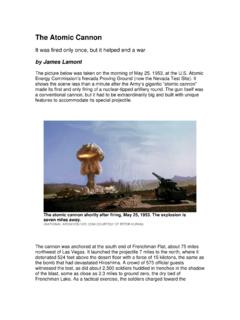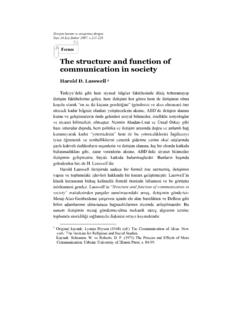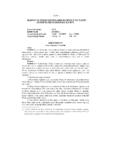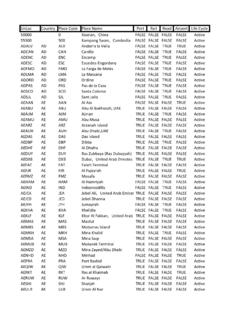Transcription of The Construction of National Identity in Modern …
1 International Journal of Humanities and Social Science Vol. 3 No. 11; June 2013 223 The Construction of National Identity in Modern Times: Theoretical Perspective H samettin na Assoc. Prof. Dr. Dumlupinar University, FEAS Political Science And International Relations Department Feyzullah nal Assist. Prof. Dr. Dumlupinar University, FEAS Public Administration Department Abstract Identity politics can be seen as the general framework of today s world politics. Ethnic, sectarian, religious and National identities are prominent as the referential points of international politics. Nevertheless, it is not so easy to comprehend what is Identity and how the National Identity can be built in different socio-political circumstances. In this context, this study argues that Identity is a Construction and formed in accordance with the exigencies of the existing conjuncture. In line with this argumentation we attempt to elaborate the transition from the ethnic identities into the National one in accompanying the Identity formation mechanism and National building strategies in theoretical perspectives.
2 Key Words: Identity , National Identity , Identity formation mechanisms, nation-building strategies, Identity politics. 1. Introduction Recent political arena suffers under hesitation and contradictory trends between globalisation and multiculturalism and between localisation and ethnic identities, and seeks monoculturalism in respect of countries and people with similar culture coming together in cultural, social, economic co-operations and strategic alliances with those of different cultures and various civilizations that tend to be left outside of these co-operations because of their differences . In this context, Identity question is at the agenda for the people who have a fear to lose their own identities. Identity is a social phenomenon which starts with the Identity formation process by means of interaction with the other or against the other . The individual tends to internalise and practice the behaviours, values and norms of the society where he or she has lived in, in order to provide his or her psychological and physical security.
3 In this way, to get an Identity one must either identify oneself with someone and/or be perceived as identical to someone else. The continuous and permanent internalisation processes of social setting are resulted in the Construction of an individual Identity within a social dimension. 2. Definition of Identity Identity is a description or, in other words, the definition of the existence and belongingness. The Identity consists of two pillars: identifier and identified. (Eralp 1997:19) In our concern, the individual is subjected identified as a self and the society is main identifier as an other . It is an alterity, otherness and an ambiguous notion which gets its meaning from what it is not, from the other as Derrida argued: All identities can possibly exist with their differance (with an a ) There is no culture or cultural Identity which does not have its other of the self (Derrida 1992: 129).
4 Because the Identity means to the other , it is defined, determined and nominated by the other . Nevertheless, Derrida distinguishes the word difference and differance as the Identity as sameness from the Identity as equivalence respectively, which is indicated in his text Difference in Speech and Phenomena written for the counter-argumentation to Heidegger s essay Identity and Difference . On the one hand, differance indicates difference as distinction, inequality, or discernibility; on the other, it expresses the interposition of delay , the interval of a spacing and temporalising that puts off until later what is presently denied, the possible that is presently impossible (Ibid.:130). Center for Promoting Ideas, USA 224 It is a very vulnerable point to bear in mind that if the Identity is solely defined by the other , the distinctive features and otherness dimension of the identified is emphasized and the common points are disregarded.
5 This kind of over-emphasizing leads to hostility, contradiction and discrepancy as well as denying, humiliating and negating the other . However, the Construction of any certain Identity is an inclusive process with the internalization of the same values of identifier, but it is also an exclusive process with the elimination of other identities. The main problem here is hidden at the responce to the question of how to realize this exclusion? In this context, there are several Identity narratives presented to the preference of the people in political worries gaining very critical significance. Although it is a fact that Identity implies both uniqueness and sameness, according to Martin, one Identity cannot be defined in isolation: the only way to circumscribe an Identity is by contrasting it against other identities (Martin 1995: 6). On the other hand, the other may bare both pejorative implications such as marginality , lack , and backwardness and positive connotations such as privileged and the preferred one (Kuran-Bur o lu 2002: 1).
6 However the comprehension of oneself as an other , with the others, is always an interpretation. At the same time, the Identity narrative borrows from history as well as from fiction and treats the person as a character in a plot (op. cit.: 7). In fact, the person as a character is not separable from its life experience. As Taylor argues Identity is partly shaped by recognition or its absence, often by the misrecognition of the others, and so a person or group of people can suffer real damage, real distortion, if the people or society around them mirror back to them a confining or demeaning or compatible picture of themselves (Taylor 1995: 25). The phenomena of authenticity, which was defined by Taylor as the right of people to be acknowledged publicly as what they really are (Ibid.:149) and the process of identification has a multi-dimensional, dynamic and permanent character. At first, neither individualistic life nor the social / societal stratification can be reduced into the constrained dimension.
7 Thus, the Identity is supposed to be multi-dimensional. The multicultural and multi-societal character of the Identity requires the necessity of a plurality of people, groups, social confrontations, mutual challenges and profound interactions and, finally, a strong possession is needed for the gained identities and these identities may be redefined in accordance with the conjuncture. However, this socialization process may lead to the creation of the newly constructed identities. The continuity of the process will lead to a permanent character in the Identity values as well. Perspectivity, continuity and dynamism reflect the pluralistic character of the Identity , and individuals usually possess more than one Identity units and exemplify a variety of identities. As Kymlicka claims, plurality is based on three pillars: One of them is history; human beings have lived as plural and multicultural social units have thus created multicultural Identity units throughout the history.
8 Second one is social structure; society has profound, inter-weaved and complicated identities. Third one is Identity constructive capacity of the human beings; the Identity is profoundly constructed by the thoughtful, planning and conscious people in plural character (Kymlicka, 1998:193-194). The acquisition of the plural identities, such as -popularly known- family, tribe, ethnic group, community, country, patrie ( National terrain in Smith s writings), nation, gender, class and civilization, are constructed within the process of socialization. By the way, different sorts of identities fall into three categories. First one of these categories is the universal Identity that is some traits which distinguish the people from the non-people and be shared by all people without any discrimination. Second one is the group Identity that is shared Identity by some people. Third one is the individual Identity that is distinctive and sui generis traits of a sole individual (Ibid.)
9 :202). 3. Identity Formation Mechanisms Identity is constructed in accordance with the special condition of the time process and dependent on time and space. The concept of Identity is introduced both, the notion of continuity and that of change without making them contradictory; on the contrary, continuity, in so far as it concerns the self in its relation with the other , is meaningless without transformation. This transformation is referred to within two factors. First; the authenticities are not natural and given by birth, but constructed within the social and historical framework. Second; the history sense of Identity means not only the positioning of Identity units within the historical process, but also changing the comprehensive and holistic character of any given common Identity unit within the historical perspective. In any certain period of history, a kind of Identity might be comparatively more influential over the people.
10 International Journal of Humanities and Social Science Vol. 3 No. 11; June 2013 225 For instance, while the religious Identity was more influential and determinant in pre- Modern Europe, with the modernization process the National Identity gained very critical significance and evenly universal character spreading over almost all countries. Moreover in today s perspective, the deprivation of National Identity for any community is perceived as unidentified in many respects. The historical character of Identity makes it changeable and temporal, while its sociality enhances its continuity (Martin 1995: 8-11). What are the affects or influences of the Identity which has a social, historical, dynamic, changeable, multi-dimensional, permanent and dependent character? The content of variable and plural identities varies depending on both densities and diversities and their influences over the individuals, and the degrees of necessities and initiative within the conditionality of time and space.
